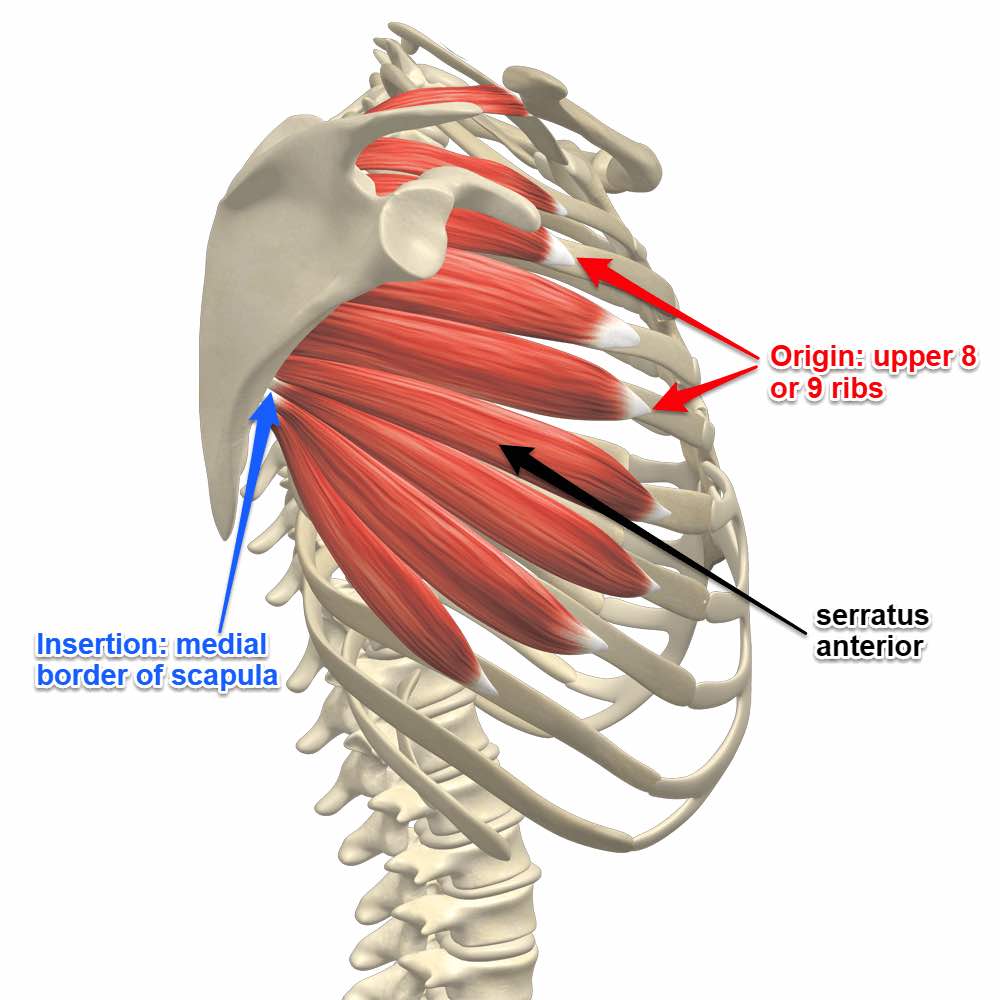
Table of Contents
Introduction
The upper body works because it provides stability for the body and motor-sensory functions to the arms, neck, shoulders, and chest. The muscles surrounding each body section have different roles and outputs that have specific jobs for body functionality. For the chest body area, the various muscles are there to support the shoulders and arms while protecting the chest cavity and the internal organs inside. Some of the different chest muscles even support the internal organs and the rest of the muscles. One of those muscles is known as the serratus anterior muscle. Today’s article looks at this muscle, how trigger points affect the serratus anterior muscle, and various actions to manage trigger points along the serratus anterior. We refer patients to certified providers who provide different techniques in pain therapies associated with trigger points to aid many suffering from pain-like symptoms along the serratus anterior muscle along the ribcage. We encourage patients by referring them to our associated medical providers based on their examination when it is appropriate. We designate that education is a great solution to asking our providers profound and complex questions at the patient’s request. Dr. Alex Jimenez, D.C., notes this information as an educational service only. Disclaimer
What Is The Serratus Anterior?
Have you been experiencing pain in your sides? Do you notice that your shoulders feel stiff when rotating backward? Or are you experiencing any cardiovascular disorders that are causing you pain? Pain can come in many forms and affect a person differently, as most of these symptoms are associated with trigger points affecting the serratus anterior muscle along the side of the ribs. The serratus anterior muscles work in the body because this muscle is located deep within the scapula (shoulder blades) and the pectoral muscles. Some of the functions that the serratus anterior provides are that it helps pull the shoulder blades forward around the thorax by allowing anteversion and protraction of the arms.

A great example is when a boxer is throwing a punch. This motor action is done with the long thoracic nerve. The long thoracic nerve originated from the C-5 and C-6 regions of the cervical spine and is the motor nerve for the serratus anterior muscle to allow an anterolateral motion for the shoulder blades that allows arm elevation. Another function of the serratus anterior is that it helps lift the ribs and provide assistance with respiration. The serratus anterior muscle also helps protect the side of the ribcage.
Trigger Points Affecting The Anterior Serratus Muscle

The serratus anterior muscle and the long thoracic nerve work hand-in-hand to provide motor function to the arms but can succumb to various injuries that can cause the development of trigger points or myofascial pain syndrome in the anterior serratus muscle. According to Dr. Travell, M.D.’s book, “Myofascial Pain & Dysfunction,” trigger points may be activated when the serratus anterior muscle has been overused and strained from excessive exercises like prolonged running, pushups, or heavy weight lifting or even extreme coughing from respiratory diseases. Other studies reveal that trigger points affecting the serratus anterior muscle can cause radiating pain along the anterior chest wall that can mimic radiculopathy and often be confused with chronic mechanical neck pain, instability in the glenohumeral, and even shoulder impingement syndrome. Trigger points are often difficult to diagnose due to the referred pain in the affected muscle. The various factors that contribute to the development of trigger points can be simple, like an overused muscle or even a slightly poor posture stance that can cause an imbalance in the body.
Trigger Point Release On The Serratus Anterior- Video
Have you been dealing with pain in the side of your ribs? What about experiencing stiffness or pain when throwing a punch? Do you feel any aches or soreness when adjusting your posture? These symptoms you are experiencing could contribute to the development of trigger points affecting the serratus anterior muscle. The serratus anterior covers the side of the ribcage and lies deep within the scapula and pectoral muscle. This muscle allows the motor function to the arms as it pulls the scapula forward around the thorax when someone throws a punch. However, when the muscle is overused, it can develop trigger points along the serratus anterior muscle and mimic chronic issues in the chest cavity. This causes referred pain to travel from the side of the ribs down to the hand, causing pain-like symptoms to the ring and pinky fingers. Fortunately, various treatments help manage trigger points in the serratus anterior muscle. The video above shows where the trigger points are located in the serratus anterior and how to release the trigger points from the affected muscle to relieve the pain and manage trigger points from returning to the muscle.
Various Actions To Manage Trigger Points Along The Serratus Anterior

When the serratus anterior is affected by trigger points, many people will often feel pain along their sides and complain about their chest hurting for an unknown reason. When this happens, they would be referred to a pain specialist like a chiropractor or a massage therapist to manage trigger points associated with the serratus anterior through various techniques. Studies reveal that techniques like intramuscular neural distribution of the serratus anterior muscle can help reduce the effects of trigger points in the affected muscle to reduce pain-like symptoms. Other methods like thoracic spinal manipulation, dry-needling, acupuncture, or stretching the muscle group can help loosen the stiff muscles and lower trigger points from forming. However, other actions that many people should consider are modifying or avoiding strenuous activities that can reactivate the serratus anterior muscle trigger points. Even when the person is sleeping, putting a pillow under to support the arm can prevent the scapula from falling forward.
Conclusion
The serratus anterior muscle is located at the side of the ribs and is deep within the scapula (the shoulder blades) and the poster muscles. The serratus anterior muscle works with the long thoracic nerve by providing motor function to the arms by allowing anterolateral motion. This allows the individual to throw a punch in a boxing match while lifting the ribs and assisting with respiration. When the serratus anterior muscle succumbs to injuries or has been overused, it can develop into trigger points and cause various issues affecting the body’s chest cavity. Trigger points are treatable through multiple therapies that can manage trigger points while reducing the pain effects rendered in the serratus anterior muscles. These therapies return mobility and motor function to the arms and the serratus anterior muscles.
References
Bautista, Alexander, et al. “Serratus Anterior Muscle Pain Syndrome: A Diagnostic Conundrum.” OUP Academic, Oxford University Press, 11 Feb. 2017, academic.oup.com/painmedicine/article/18/8/1600/2990174?login=false.
Long, Kirsten, and Forshing Lui. “Anatomy, Thorax, Long Thoracic Nerve.” In: StatPearls [Internet]. Treasure Island (FL), StatPearls Publishing, 31 July 2021, www.ncbi.nlm.nih.gov/books/NBK535396/.
Lung, Kirsten, et al. “Anatomy, Thorax, Serratus Anterior Muscles – NCBI Bookshelf.” In: StatPearls [Internet]. Treasure Island (FL), StatPearls Publishing, 7 Oct. 2021, www.ncbi.nlm.nih.gov/books/NBK531457/.
Travell, J. G., et al. Myofascial Pain and Dysfunction: The Trigger Point Manual: Vol. 1:Upper Half of Body. Williams & Wilkins, 1999.
Yi, Kyu-Ho, et al. “Intramuscular Neural Distribution of the Serratus Anterior Muscle: Regarding Botulinum Neurotoxin Injection for Treating Myofascial Pain Syndrome.” Toxins, MDPI, 11 Apr. 2022, www.ncbi.nlm.nih.gov/pmc/articles/PMC9033065/.
Disclaimer
Disclaimers
Professional Scope of Practice *
The information herein on "Trigger Points Affecting The Serratus Anterior" is not intended to replace a one-on-one relationship with a qualified health care professional or licensed physician and is not medical advice. We encourage you to make healthcare decisions based on your research and partnership with a qualified healthcare professional.
Blog Information & Scope Discussions
Welcome to El Paso's wellness blog, where Dr. Alex Jimenez, DC, FNP-C, a board-certified Family Practice Nurse Practitioner (FNP-C) and Chiropractor (DC), presents insights on how our team is dedicated to holistic healing and personalized care. Our practice aligns with evidence-based treatment protocols inspired by integrative medicine principles, similar to those found on dralexjimenez.com, focusing on restoring health naturally for patients of all ages.
Our areas of chiropractic practice include Wellness & Nutrition, Chronic Pain, Personal Injury, Auto Accident Care, Work Injuries, Back Injury, Low Back Pain, Neck Pain, Migraine Headaches, Sports Injuries, Severe Sciatica, Scoliosis, Complex Herniated Discs, Fibromyalgia, Chronic Pain, Complex Injuries, Stress Management, Functional Medicine Treatments, and in-scope care protocols.
Our information scope is limited to chiropractic, musculoskeletal, physical medicine, wellness, contributing etiological viscerosomatic disturbances within clinical presentations, associated somato-visceral reflex clinical dynamics, subluxation complexes, sensitive health issues, and functional medicine articles, topics, and discussions.
We provide and present clinical collaboration with specialists from various disciplines. Each specialist is governed by their professional scope of practice and their jurisdiction of licensure. We use functional health & wellness protocols to treat and support care for the injuries or disorders of the musculoskeletal system.
Our videos, posts, topics, subjects, and insights cover clinical matters, issues, and topics that relate to and directly or indirectly support our clinical scope of practice.*
Our office has reasonably attempted to provide supportive citations and has identified the relevant research studies or studies supporting our posts. We provide copies of supporting research studies available to regulatory boards and the public upon request.
We understand that we cover matters that require an additional explanation of how they may assist in a particular care plan or treatment protocol; therefore, to discuss the subject matter above further, please feel free to ask Dr. Alex Jimenez, DC, APRN, FNP-BC, or contact us at 915-850-0900.
We are here to help you and your family.
Blessings
Dr. Alex Jimenez DC, MSACP, APRN, FNP-BC*, CCST, IFMCP, CFMP, ATN
email: coach@elpasofunctionalmedicine.com
Licensed as a Doctor of Chiropractic (DC) in Texas & New Mexico*
Texas DC License # TX5807
New Mexico DC License # NM-DC2182
Licensed as a Registered Nurse (RN*) in Texas & Multistate
Texas RN License # 1191402
ANCC FNP-BC: Board Certified Nurse Practitioner*
Compact Status: Multi-State License: Authorized to Practice in 40 States*
Graduate with Honors: ICHS: MSN-FNP (Family Nurse Practitioner Program)
Degree Granted. Master's in Family Practice MSN Diploma (Cum Laude)
Dr. Alex Jimenez, DC, APRN, FNP-BC*, CFMP, IFMCP, ATN, CCST
My Digital Business Card
